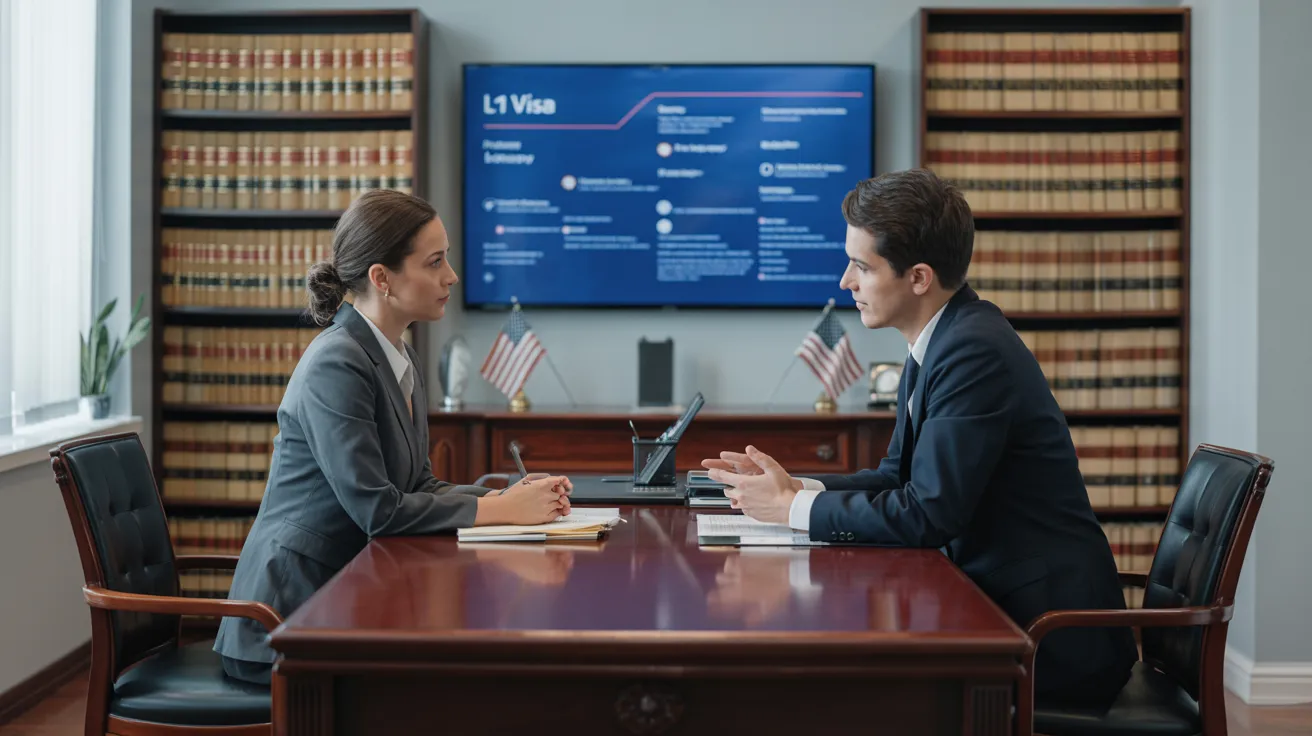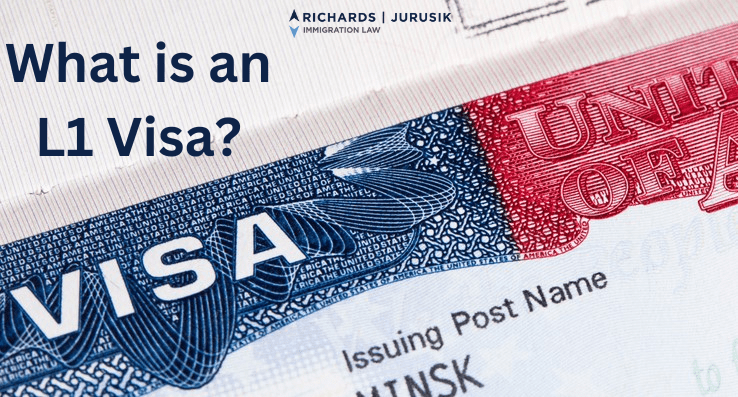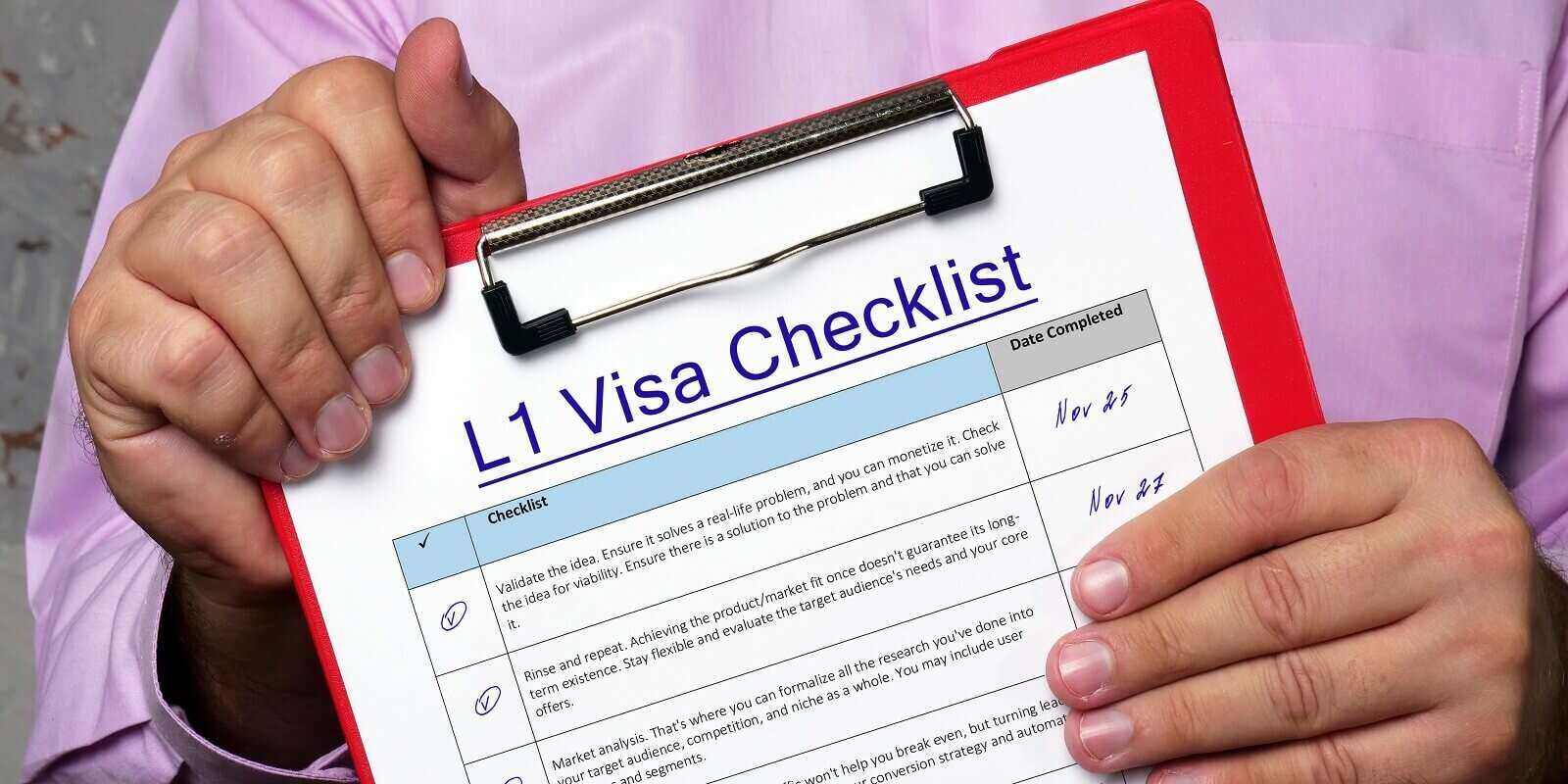Unlocking Opportunities: A Comprehensive Overview to the L1 Visa Process
The L1 visa process offers a crucial path for international companies seeking to transfer key workers throughout boundaries. Recognizing the nuances of eligibility criteria, the differences between L-1A and L-1B visas, and the complexities of the application process can considerably impact a candidate's success. Steering this complex landscape is not without its challenges, and cautious focus to documentation and company sponsorship is crucial. As we discover the key elements of this procedure, the methods for conquering prospective obstacles will certainly come to be evident, exposing how informed preparation can open up a globe of chances.
Comprehending the L1 Visa
Comprehending the L1 visa involves identifying its significance as a crucial tool for multinational business looking for to transfer competent workers in between global workplaces. This non-immigrant visa group helps with the movement of execs, managers, and specialized expertise employees to the USA, consequently making it possible for companies to keep operational continuity and harness global ability efficiently. The L1 visa is separated into 2 key classifications: L-1A for supervisors and executives, and L-1B for workers possessing specialized knowledge.The L1 visa serves a critical role in boosting a firm's one-upmanship in the international industry. By allowing companies to relocate their crucial employees, companies can guarantee that critical projects are managed by certified people that are already acquainted with the business's culture and functional procedures. L1 Visa. This interior transfer mechanism not only fosters expertise sharing yet likewise advertises innovation and collaboration across borders.Moreover, the L1 visa is often favored for its reasonably uncomplicated application procedure contrasted to various other visa categories, as it enables double intent, permitting owners to go after permanent residency while on a momentary job visa. This feature makes the L1 visa especially appealing for both employers and staff members, as it streamlines the path for competent professionals to develop long-term residency in the USA
Qualification Requirements
Eligibility for the L1 visa hinges on a number of crucial requirements that guarantee both the employee and the company fulfill certain certifications. This non-immigrant visa is designed for multinational business to move employees from consular services to U.S. counterparts.Firstly, the company should be a certifying company, which includes a moms and dad company, branch, associate, or subsidiary of an U.S. service. The company needs to have been doing company for at the very least one year both in the U.S. and abroad. This assures that the company has sufficient functional security and a legit presence.Secondly, the staff member should hold a supervisory, exec, or specialized expertise position. For L1A visas, the applicant should demonstrate managerial or executive credentials, while L1B visas concentrate on specialized expertise pertaining to the company's items, solutions, or procedures. In addition, the employee should have benefited the international entity for at the very least one continual year within the last three years before their application.Lastly, the worker's duty in the united state must straighten with their previous setting, making sure that their skills and competence are leveraged for the company's benefit.

Types of L1 Visas
The L1 visa classification comprises two primary types designed to help with the transfer of employees within international firms: the L1A visa for managers and execs, and the L1B visa for staff members with specialized understanding. Each type serves unique purposes and has specific qualification criteria.The L1A visa is tailored for individuals that hold supervisory or executive positions within a firm. This visa enables high-level staff members to move to a united state branch, subsidiary, or associate of the exact same company. Applicants for the L1A visa have to demonstrate that they have actually been utilized in a supervisory or executive ability for a minimum of one constant year within the previous three years before their application. Furthermore, this visa offers a longer period of stay, initially given for 3 years, with the possibility of extensions for approximately seven years.In contrast, the L1B visa is meant for professionals with specialized understanding pertaining to the firm's items, solutions, or processes. To qualify, candidates have to prove that their competence is essential to the company which they have helped a minimum of one continual year within the last 3 years in a function that needed this specialized knowledge. The L1B visa is at first approved for three years, with extensions readily available for as much as 5 years.Both visa kinds are necessary for business seeking to enhance their worldwide procedures by leveraging competent employees, thus advertising technology and effectiveness within the united state market.
Application Process
Guiding via the L1 copyright process entails several vital actions that must be carefully followed to ensure a successful result. The procedure starts with the united state company, who should first establish eligibility by demonstrating a qualifying partnership with the foreign entity and validating that the employee satisfies the particular demands for the L1 visa classification being sought.Once eligibility is verified, the employer initiates the procedure by submitting Form I-129, the Petition for a Nonimmigrant Employee, with the United State Citizenship and Immigration Services (USCIS) This form has to be gone along with by a thorough summary of the work obligations to be performed, the business structure of both the U.S. and international entities, and the staff member's certifications. It's crucial to verify that all information is precise and total, as omissions or errors can result in delays or denials.Upon authorization of the I-129 application, the following step involves the staff member using for the L1 visa at an U.S. consular office or consular office in their home nation. This stage calls for the conclusion of Form DS-160, the Online Nonimmigrant copyright, and setting up an interview. During the meeting, the applicant must offer evidence sustaining their certifications and the employer's petition.After the visa is approved, the worker can get in the United States to operate in the marked role. Generally, careful preparation and adherence to every step of the application procedure are essential for an effective L1 visa end result.
Called for Documentation

Vital Types Required
Steering the L1 Visa procedure calls for cautious interest to the essential forms and paperwork essential for a successful application. The key form needed is the Kind I-129, Request for a Nonimmigrant Employee, which must be completed and submitted by the united state employer (L1 Visa). This kind outlines the information of the employment offer and the credentials of the staff member seeking the L1 Visa.Alongside Form I-129, the applicant will certainly require to full Kind I-539 if accompanying member of the family are likewise requesting visas. In addition, the company should provide evidence of the certifying connection between the U.S. entity and the foreign entity, often demanding the submission of business documents such as write-ups of unification or monetary statements.Moreover, it is necessary to include the L Category Supplement to Kind I-129, which defines the kind of L Visa being requested-- either L-1A for supervisors and executives or L-1B for employees with specialized knowledge. Applicants ought to ensure that all types are signed and dated suitably, as insufficient submissions can lead to delays or rejections. Properly assembling these vital kinds lays the structure for a smoother L1 copyright process
Sustaining Evidence Requirements
Sustaining paperwork is essential for an effective L1 copyright, as it corroborates the insurance claims made in the request. Applicants have to supply an array of files to show eligibility for the visa, which is classified into two main types: proof of the certifying connection in between the U.S. and international entities and proof of the applicant's qualifications.To develop the relationship, applicants need to send paperwork such as company business charts, financial declarations, and proof of ownership. These files verify that the foreign business has a qualifying relationship with the U.S. employer, whether as a moms and dad business, subsidiary, branch, or affiliate.For the candidate's qualifications, vital documents include a detailed work letter from the foreign company, laying out the applicant's job title, responsibilities, and period of work. In addition, academic credentials, such as levels and diplomas, need to be given to prove the applicant's knowledge in the pertinent field.
Company Sponsorship Documents
Employer sponsorship records play a necessary duty in the L1 copyright procedure, as they validate the united state employer's commitment to the candidate's work in the USA. These papers are vital for showing the employer's qualification to fund the applicant for the L1 Visa.Key documents normally called for consist of a thorough work letter from the united state company, which lays out the task title, obligations, and the nature of the work partnership. Furthermore, the employer has to provide evidence of the business's authenticity, such as business licenses, tax returns, and business graphes, highlighting the connection in between the U.S. entity and the international company.Furthermore, evidence of the staff member's certifying connection with the foreign business is essential. This might include documents showing the worker's function in the foreign entity, such as pay stubs, employment agreement, or performance analyses.
Typical Challenges
Maneuvering the L1 visa procedure presents a number of usual difficulties that candidates need to be aware of (L1 Visa). Secret issues frequently include stringent documentation demands, possible hold-ups in handling times, and the requirement for rigorous legal conformity. Recognizing these obstacles can assist applicants much better prepare and reduce risks throughout their copyright journey
Paperwork Requirements
The L1 copyright procedure usually offers significant difficulties associated to paperwork needs. Applicants should provide considerable documentation to establish eligibility, which can result in complication and possible hold-ups. Key records consist of evidence of a qualifying partnership between the united state and foreign company, evidence of the candidate's employment background, and detailed information regarding the job function in the U.S.One typical difficulty is gathering sufficient proof to show the nature of the certifying connection. Business typically battle to present clear business graphes or financial declarations that show the link between the entities. Additionally, ensuring that letters of support from companies precisely reflect the candidate's job tasks and certifications is vital, as unclear summaries can result in denials.Another issue occurs from the demand for comprehensive job descriptions that line up with the L1 visa categories. Candidates need to verbalize not only their existing role yet additionally their managerial or specialized understanding obligations plainly. This necessitates a detailed understanding of both the candidate's placement and the regulatory language made use of in L1 applications.
Handling Dead Time
Experiencing delays in handling times is a common difficulty faced by L1 visa candidates, usually leading to frustration and unpredictability. Numerous factors add to these hold-ups, consisting of high application quantities, raised scrutiny of applications, and administrative stockpiles within the U.S. Citizenship and Immigration Services (USCIS) Applicants might locate that handling times can vary greatly depending on the service center managing their application, as each facility has its very own workload and efficiency levels. Additionally, the complexity of the candidate's case, such as the need for comprehensive paperwork or information, can even more prolong wait times.In some instances, problems connected to the applicant's existing migration condition or previous visa history might additionally bring about added delays, as USCIS might call for further evaluation or details. It is essential for candidates to remain proactive during this duration, preserving open interaction with their employers and legal agents to address any kind of prospective worries promptly.Understanding these handling time challenges can aid L1 visa applicants get ready for feasible delays and mitigate the effect on their change and profession strategies. Persistence and persistance are important virtues in navigating this detailed procedure.
Legal Compliance Issues
Lots of L1 visa applicants run into legal conformity problems that can complicate their journey toward acquiring the visa. Understanding and sticking to the details policies established by the U.S. Citizenship and Migration Provider (USCIS) is essential. Typical challenges include showing the certifying partnership between the international and united state companies, in addition to confirming that the candidate possesses the requisite customized knowledge or supervisory capacity.Additionally, applicants need to offer thorough paperwork outlining their work duties, business structure, and economic viability of the U.S. entity. Inadequate or inaccurate documents can cause hold-ups or perhaps rejections. Companies must also assure that they adhere to labor laws, consisting of wage and functioning condition criteria, which can influence visa eligibility.Another typical problem includes maintaining conformity with the regards to the visa when provided. Changes in work standing, work obligations, or company structure can necessitate changes to the visa, which if not addressed without delay can lead to lawful issues. Because of this, staying notified concerning conformity requirements and looking for legal guidance when required is necessary to browse the complexities of the L1 visa process efficiently.
Tips for Success
Success in the L1 copyright process often hinges on careful preparation and attention to information. To improve your opportunities of authorization, start by thoroughly understanding the qualification needs for both the L1A and L1B visa categories. Assess whether your placement at the company certifies as supervisory, exec, or specialized expertise, as this classification notably influences your application.Next, gather extensive paperwork that validates your claims. This includes organizational graphes, thorough task summaries, and proof of the firm's functional framework. Clear and succinct evidence of the qualifying partnership between the U.S. entity and the international entity is crucial. Validate that all records are organized practically and presented in a specialist way, as this mirrors your dedication and severity regarding the application.Engage the services of a seasoned migration attorney who focuses on L1 visas. Their knowledge can prove important, assisting you with complex policies and ensuring that all paperwork abides by current regulations. Furthermore, plan for the meeting by exercising solutions to typical concerns and being prepared to review your function and contributions to the business extensive.
Regularly Asked Concerns
Can Family Members Come With the L1 Visa Holder?
Yes, relative of L1 visa holders, including partners and unmarried kids under 21, can go along with the main visa holder. They may likewise make an application for L2 visas, which permit them to reside in the United States.
Exactly How Lengthy Can I Remain On an L1 Visa?
The L1 visa permits preliminary remains of approximately 3 years, with the opportunity of expansion. L1A visa owners might stay for a maximum of seven years, while L1B visa holders can continue to be for 5 years.
Can L1 Visa Owners Request an Environment-friendly Card?
Yes, L1 visa holders can use for a copyright. They may go after permanent residency through employment-based categories, usually calling for sponsorship from their company, offered they fulfill the required certifications and documentation needs.
What Occurs if My L1 copyright Is Rejected?
If your L1 copyright is denied, you may get a notification outlining the factors for rejection. You can look for to appeal the decision, reapply, or check out different visa alternatives based upon your conditions.
Exist Any Kind Of Travel Limitations With an L1 Visa?
An L1 visa usually enables worldwide traveling; nevertheless, re-entry to the united state is contingent upon keeping valid status. Tourists need to ensure compliance with visa conditions to stay clear of problems upon return
Verdict

Comments on “L1 Visa Process”